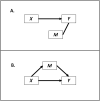Mediators, Moderators, and Covariates: Matching Analysis Approach for Improved Precision in Cognitive-Communication Rehabilitation Research
- PMID: 36306506
- PMCID: PMC9940892
- DOI: 10.1044/2022_JSLHR-21-00551
Mediators, Moderators, and Covariates: Matching Analysis Approach for Improved Precision in Cognitive-Communication Rehabilitation Research
Abstract
Purpose: The dual goals of this tutorial are (a) to increase awareness and use of mediation and moderation models in cognitive-communication rehabilitation research by describing options, benefits, and attainable analytic approaches for researchers with limited resources and sample sizes and (b) to describe how these findings may be interpreted for clinicians consuming research to inform clinical care.
Method: We highlight key insights from the social sciences literature pointing to the risks of common approaches to linear modeling, which may slow progress in clinical-translational research and reduce the clinical utility of our work. We discuss the potential of mediation and moderation analyses to reduce the research-to-practice gap and describe how researchers may begin to implement these models, even in smaller sample sizes. We discuss how these preliminary analyses can help focus resources for larger trials to fully encapsulate the heterogeneity of individuals with cognitive-communication disorders.
Results: In rehabilitation research, we study groups, but we use the findings from those studies to treat individuals. The most functional clinical research is about more than establishing only whether a given effect exists for an "average person" in the group of interest. It is critical to understand the active ingredients and mechanisms of action by which a given treatment works (mediation) and to know which circumstances, contexts, or individual characteristics might make that treatment most beneficial (moderation).
Conclusions: Increased adoption of mediation and moderation approaches, executed in appropriate steps, could accelerate progress in cognitive-communication rehabilitation research and lead to the development of targeted treatments that work for more clients. In a field that has made limited progress in developing successful interventions for the last several decades, it is critical that we harness new approaches to advance clinical-translational research results for complex, heterogeneous groups with cognitive-communication disorders.
Figures




References
-
- Altman, D. G. , & Royston, P. (2006). The cost of dichotomising continuous variables. British Medical Journal, 332(7549), 1080. https://doi.org/10.1136/bmj.332.7549.1080 - PMC - PubMed
-
- Ananth, C. V. , & Schisterman, E. F. (2017). Confounding, causality, and confusion: The role of intermediate variables in interpreting observational studies in obstetrics. American Journal of Obstetrics & Gynecology, 217(2), 167–175. https://doi.org/10.1016/j.ajog.2017.04.016 - PMC - PubMed
-
- Austin, P. C. , & Steyerberg, E. W. (2015). The number of subjects per variable required in linear regression analyses. Journal of Clinical Epidemiology, 68(6), 627–636. https://doi.org/10.1016/j.jclinepi.2014.12.014 - PubMed
-
- Bloom, H. S. , Richburg-Hayes, L. , & Black, A. R. (2007). Using covariates to improve precision for studies that randomize schools to evaluate educational interventions. Educational Evaluation and Policy Analysis, 29(1), 30–59. https://doi.org/10.3102/0162373707299550
-
- Burt, D. B. , Zembar, M. J. , & Niederehe, G. (1995). Depression and memory impairment: A meta-analysis of the association, its pattern, and specificity. Psychological Bulletin, 117(2), 285–305. https://doi.org/10.1037/0033-2909.117.2.285 - PubMed
Publication types
MeSH terms
Grants and funding
LinkOut - more resources
Full Text Sources
Miscellaneous

